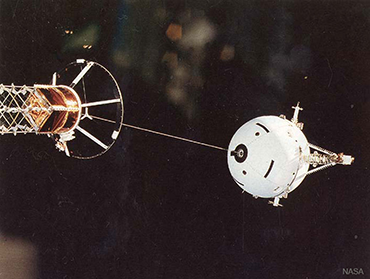Could humans build a tall tower or giant rope to space?
Ad Astra’s massive space antenna isn’t real, but scientists do think about building big to reach the stars

Scientists have been thinking up technologies that could take humans to the stars without rockets. A giant tower would probably sink into the planet. A cable that reaches into orbit could work — but only if researchers can find a strong enough material to build it.
metamorworks/iStock/Getty Images Plus; adapted by L. Steenblik Hwang
Astronaut Roy McBride peers out over the Earth at the start of the new sci-fi flick Ad Astra. It’s not an unusual view for him. He does mechanical work atop an international space antenna. This spindly structure stretches up toward the stars. But this day, McBride’s sweet view is interrupted by an explosion that hurtles him off the antenna. He plummets from the blackness of space toward Earth until his parachute opens, slowing his descent.
In the movie, the space antenna looks like pipes stacked upon pipes that reach into space. But could anyone build something that tall? And can people actually climb up from Earth into space?
A tall order
There’s no set line between Earth and space. Where space begins depends on whom you ask. But most scientists agree that space starts somewhere between 80 and 100 kilometers (50 and 62 miles) above Earth’s surface.
Building a skinny tower that tall isn’t possible. Anyone who’s stacked up a tower of Legos knows that at some point the structure won’t be sturdy enough to hold its own weight. It eventually tilts to the side, before crashing and scattering its bricks. A better strategy is to build something like a pyramid that narrows as it grows in height.

But even if we could build a tower that tall, there’d be problems, says Markus Landgraf. He’s a physicist at the European Space Agency. He’s based in Noordwijk, the Netherlands. A tower that could reach space would be too heavy for the Earth to support, he says. Earth’s crust isn’t very deep. It averages only around 30 kilometers (17 miles). And the mantle below is a bit squishy. The tower’s mass would push too hard on the Earth’s surface. “It would basically create a ditch,” Landgraf says. And, he adds, “It would keep doing so over thousands of years. It would go deeper and deeper. It would not be pretty.”
So physicists have concocted another solution — one that turns the tower approach on its head. Some scientists have proposed hanging a ribbon in Earth’s orbit and dangling its end down to the surface. Then people could climb up into space instead of blasting off in rockets.
Going up
This concept is called the “space elevator.” It’s an idea first floated by a Russian scientist in the late 1800s. Since then, space elevators have shown up in many science fiction tales. But some scientists take the idea seriously.
To stay in orbit, the elevator would have to be a lot longer than 100 kilometers — more like 100,000 kilometers (62,000 miles) long. That’s roughly a quarter of the way from Earth’s surface to the moon.
The end of the giant ribbon swinging around the planet would need to be in geosynchronous orbit. That means that it stays positioned above the same spot on the Earth’s surface and rotates at the same speed as Earth.
“The way it stays up there is exactly the same as if you put a rock on the end of a string and tossed it around your head. There’s a tremendous force — centrifugal [Sen-TRIF-uh-gul] force — pulling the rock outward,” explains Peter Swan. Swan is the director of the International Space Elevator Consortium. He’s based in Paradise Valley, Ariz. The group is promoting (you guessed it) the development of a space elevator.
Just like the rock on the string, a counterweight at the space end of the elevator could help it stay taught. But whether one is needed would depend on the rope’s weight and length.
Swan and other ISEC members are working to make the space elevator a reality because it could make it easier and cheaper to send people and equipment into space. Swan estimates that today it would cost around $10,000 to send a pound of stuff to the moon. But with a space elevator, he says, the cost might fall to near $100 per pound.
Next stop: space
To leave the planet, a vehicle called a climber could attach to the ribbon. It would grip the ribbon on both sides with a pair of wheels or belts, much like a treadmill. They would move and pull people or cargo up the ribbon. You might think of it, says Bradley Edwards, as being “essentially like a vertical railroad.” Edwards is physicist based in Seattle, Wash. He wrote reports for NASA in 2000 and 2003 about the likelihood of developing space elevators.
A person could reach low-Earth orbit in around an hour, Edwards says. Traveling to the end of the tether would take a couple of weeks.
“You get in and you barely feel it move … it’d be sort of like a normal elevator,” Edward says. Then you’d see the anchor station, where the ribbon is tied to Earth, dropping away. You might start slow, but the elevator could reach speeds of between 160 to 320 kilometers per hour (100 to 200 miles per hour).
The view would change from watching clouds and lightning over the Earth’s surface to seeing the curve of the Earth. You’d pass the International Space Station. “And by the time you get to geosynchronous [orbit], you can put your hand up and cover the Earth,” Edwards says.
But you wouldn’t have to stop there. Because of how the end of the elevator is being flung around, you could use it to slingshot yourself to another planet. This is just like swinging a rock on a string around your head. If you let go of the string, the rock goes flying. “The same thing works with a space elevator,” Edwards says. In this case, the destination could be the moon, Mars or even Jupiter.
Spinning a yarn
The biggest challenge of building a space elevator may be the 100,000-kilometer-long tether. It would have to be incredibly strong to handle the gravitational and centrifugal forces pulling on it.
The steel used in tall buildings wouldn’t work for a space elevator cable. You’d need a higher mass of steel than all the mass in the universe, Landgraf noted in a 2013 TEDx talk.
Instead, physicists are looking to carbon nanotubes. “Carbon nanotubes are one of the strongest materials we know about,” says chemical engineer Virginia Davis. Davis works at Auburn University in Alabama. Her research focuses on carbon nanotubes and graphene, another carbon material. These are nanoscale materials, with at least one dimension around one thousandth the thickness of a human hair.
The structure of carbon nanotubes resembles a chain link fence that’s been rolled into a tube. Instead of being made of wire, carbon nanotubes are made only of carbon atoms, Davis explains. Carbon nanotubes and graphene are “way stronger than most other materials, especially given that they’re really super lightweight,” she says.
“We already can make fibers and cables and ribbons out of carbon nanotubes,” Davis says. But no one has made anything out of carbon nanotubes or graphene that even approaches tens of thousands of kilometers yet.
Edwards estimated that the strength the cable would need to have a strength of around 63 gigapascals. That’s a huge number, thousands of times higher than the strength of steel. It’s dozens of times more than some of the toughest materials known, such as the Kevlar used in bulletproof vests. In theory, carbon nanotubes’ strength reaches far past 63 gigapascals. But only in 2018 did researchers make a bundle of carbon nanotubes that surpassed that.
The strength of a massive ribbon, though, would not only depend on the material used but also on how it is woven. Defects, such as missing atoms in the carbon nanotubes could also affect overall strength, Davis says, as well as other materials used in the ribbon. And, if successfully built, the space elevator would have to withstand all manner of threats from lightning strikes to collisions with space junk.
“Certainly, there’s a long way to go,” says Davis. “But a lot of things that we used to think of a science fiction, which is where this idea started, have become science fact.”







